On April 14, 2021, US President Joe Biden announced that US troops in Afghanistan would start to withdraw as of the first of May, with a full withdrawal concluded by September 11. This step, thus, ended the United States’ longest war, after two decades of the American military campaign on the Asian country.
Early in August, Afghan provinces started to fall one after another into the hands of the Taliban within two weeks, until Kabul succumbed to its new rulers in mid-August.
After the Taliban took up the ruins of the government in Kabul, it went on taking over all provinces of Afghanistan. By September 21, it declared full control over the country after conquering the province of Panjshir.
Ten Days through August: Provinces Fall Apart
From August 6 to August 16, the Taliban was able to take control of almost all of the Afghan provinces. Below is a daily timeline of how the Afghan territories fell under the control of the Taliban, one after the other:
August 6, 2021: The Taliban seizes Zaranj, the capital of Nimruz Province (south) near the Iranian border, marking the first regional capital to fall.
August 7, 2021: The Taliban takes over Jawzjan province (north).
August 8, 2021: The Taliban seizes Sari Pul, the capital of the northern Sari Pul Province, as well as the provinces of Kunduz and Taloqan.
August 10, 2021: The Taliban takes control of Farah, the capital of the western Farah Province, in addition to Balkhumari, the capital of Baghlan province (central).
August 11, 2021: The Taliban seizes Faizabad, the capital of Badakhshan Province (north).
August 12, 2021: The Taliban takes control of the capital of Ghazni province, the southeast gate to the capital, 150 km away from Kabul, and seizes Kandahar and Herat, the second and third largest cities in the country and its ancient stronghold, respectively.
August 13, 2021: The Taliban takes over Lashkar Gah, the capital of Helmand Province (south), as well as the provinces of Badghis, Uruzgan, Zabul, and Ghor.
August 14, 2021: The Taliban seizes Mazar-i-Sharif in Balkh province, then Bul Alam, the capital of Logar province, 70 km south of Kabul.
August 15, 2021: The Taliban takes over the ruins of the government in the capital, Kabul, and gets hold of the presidential palace as President Ashraf Ghani fled to the UAE. The Taliban also took control of Jalalabad, the capital of Nangarhar province.
August 15, 2021: The US evacuates diplomats from the American Embassy in Kabul.
August 16, 2021: Biden says, “I do not regret my decision to end the American fighting in Afghanistan,” criticizing the rapid collapse of the Afghan government.
August 16, 2021: Thousands of civilians gather at Kabul airport in a desperate attempt to leave Afghanistan.
September 22, 2021: The Taliban declares full control over Afghanistan after seizing the province of Panjshir in the northeast of the country.
How Did the Airport Crisis Break Out?
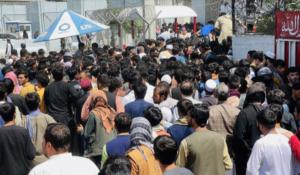
Over the days before the Taliban took control of Kabul on August 15, hundreds of Afghans fled the country on the few commercial flights available. Flight data from FlightRadar24 shows that on August 14 and 15, about 21 international flights departed from Kabul to Georgia, India, Iran, Pakistan, Qatar, Turkey, the UAE, and Uzbekistan.
Following the fall of Kabul, Taliban fighters were deployed at several points in the capital. The deployment, Taliban sources reported, was coordinated with the Americans to be distanced from the US troops’ deployment points to avoid any possible clashes. The US troops were securing the capital’s airport, Hamid Karzai International Airport, to evacuate diplomats, Americans, and foreign nationals.
Meanwhile, rumors circulated among residents of the capital and on social media that Western countries – particularly the US and Canada – would evacuate those wishing to immigrate regardless of visa and other travel documents, leading to crowds heading towards the airport. Chaos and crowding prevailed at the airport, with an estimated three thousand Afghans rallying into the airport and its surroundings hoping to leave.
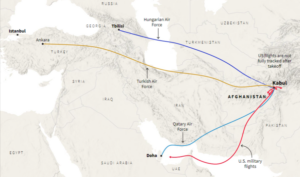
It is noteworthy that, at the time of the chaos, there were about 2,500 US troops at the airport, later reinforced by the Pentagon to 6,000 with troops from the 82nd Airborne Division, in addition to over 1,000 British troops, and smaller platoons from other NATO members, including France, Germany, and Turkey.
Due to the overwhelming chaos that spread around the airport, and the anticipation of a worsening situation, the number of US troops in Kabul was raised, following a meeting between General Kenneth McKenzie, Commander of US Central Command, with Taliban representatives on Sunday, August 15, in Doha. The Taliban representatives were informed not to interfere in the US mission at the airport and the evacuation of diplomats and embassy staff.
As a result of the massive stampede among Afghan citizens seeking to board the American evacuation planes, US forces opened fire into the air to control the chaos, and 10 Afghan citizens were killed due to crowding and US fire.
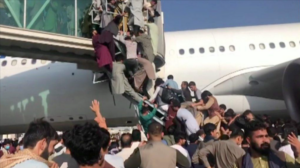
Along the same line, a US official reported that shooting in the air at Kabul airport was intended to prevent Afghans from boarding military planes, and pointed out that military flights from Kabul are intended only for transporting diplomats and embassy staff.
In an official statement, Pentagon spokesperson John Kirby explained on August 16 that the security incidents at the airport on Sunday evening involved “armed individuals shooting at US forces,” and that the US forces “did respond to hostile threats, resulting in the death of two of its soldiers.”
Kirby added, “I want to reiterate that while our mission is not offensive, our forces have the inherent right of self-defense, and they will respond accordingly to threats and attacks,” explaining that the attack was carried out by two armed individuals belonging to the Taliban.
Kirby stressed that General McKenzie’s meeting “was very clear and firm in his discussions with Taliban leaders that any attack on our people or on our operations at the airport would be met swiftly with a very forceful response.”
In the same vein, the US Department of State and the Pentagon issued a joint statement that the
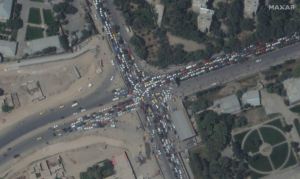
US would take over air traffic control at the airport. They added, “We will accelerate the evacuation of thousands of Afghans eligible for US Special Immigrant Visas.”
By Monday morning, US forces reportedly set up large roadblocks on roads and streets near the airport, aiming to slow and control fleeing Afghans.
Notably, Hamid Karzai International Airport (HKIA) suspended all commercial flights following the shooting incident, asking travelers to avoid crowding at the airport.
Senior Taliban leader Amir Khan Muttaqi said on August 22 that “America, with all its power and facilities, failed to bring order to the airport,” adding, “There is peace and calm throughout the country, but there is chaos only at Kabul Airport.”
Evacuation arrangements
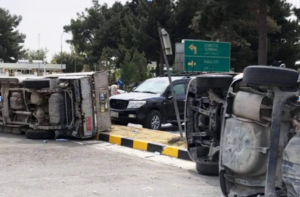
After commercial flights were halted, the military evacuation began, and Turkish Airlines conducted the last commercial evacuation before closing Afghan airspace on August 16. Two days later, US defense officials stated in a press conference in the Pentagon that, “42 US military aircraft – 37 C17s and five C130s – transported 11,200 American personnel and 7,800 allied personnel out of Afghanistan yesterday.”
They added that a plane leaves Kabul airport every 39 minutes, and that there are more than 10 thousand people at the airport waiting to depart.
Over time, many Afghans found it increasingly difficult to enter the airport, even those who had permits to travel abroad. The head of the US Federal Commission on International Religious Freedom, Nadine Mainza, told the BBC that 125 people from the Hazara minority had converted to Christianity and had been trying to enter the airport for three days, but were unable to do so.
On August 17, the Taliban spokesperson Zabihullah Mujahid declared that the organization would not agree to an extension for US mission, adding that Afghans would be prevented from going to the airport, stressing that “there is a risk that people will lose their lives” in the chaos at the airport.
The next day, German diplomat Markus Butzel said the Taliban had informed Germany that Afghans with legal documents would be able to travel on commercial flights after the August 31 deadline to end the evacuations.



